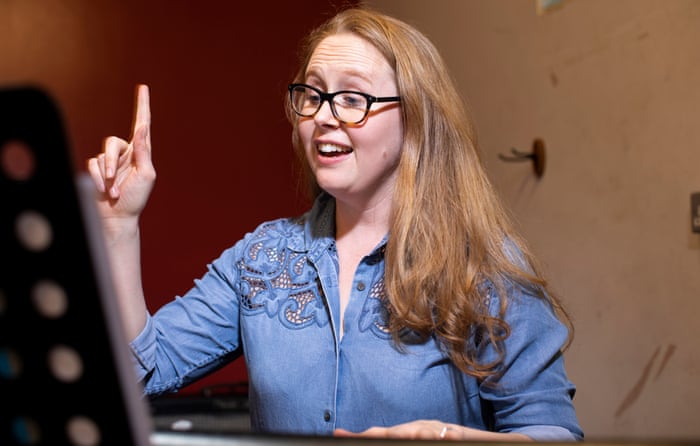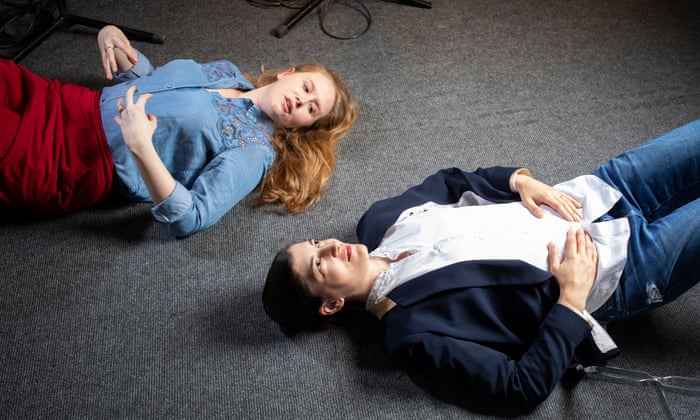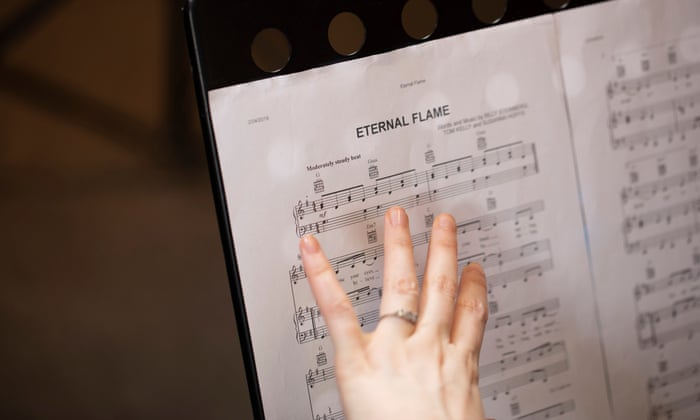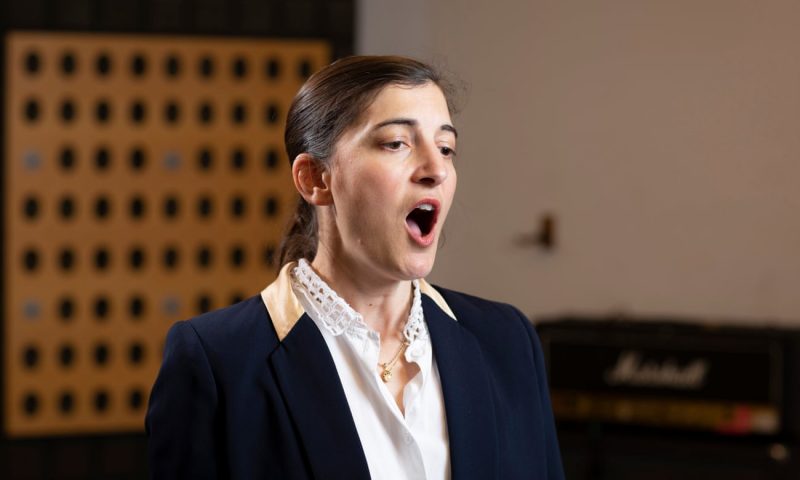I’d been too scared to sing since childhood – could I find my voice?
Central photo: ‘The kids have started to tell me to shut up, but I can’t. I’m obsessed’ … Paula Cocozza. Photograph: David Levene/The Guardian
Nearly forty years after being told she was making a racket, Paula Cocozza decided it was time to confront the sound of silence
My singing voice is a part of my body that I have for years disowned. I was a child when I let it go. Of this moment I remember only the bright orange carpet of our lounge, the spiral rug. When someone remarked on my “racket”, I guess my head dropped and floor is all I saw. But as I was eight or nine, and I’m now 47, I can’t be sure. I know only this: in that moment, I shut my mouth to singing. For decades, scarcely a song seeped out.
All my life, I have tried to square the longing to sing with the fear of being heard. There have been times – as a teenager in love with a guitarist, for instance, and at my nan’s funeral – when I have yearned to join my voice with others’ voices. At birthday celebrations, I latch on to the handful of low notes familiar from speech, like finding a cluster of friends at a party of strangers, and skip every other word. My version goes: “Happy birthday … Happy birthday … Happy … Susan … you!” Karaoke was invented the year before I was born, but I have never tried it.
Instead, I developed a sort of soundless singing, in which the one safe place to do it was in my head. I am only now learning that I had in effect joined a vast, global choir of silent singers, all scarred by some childhood slight and unable to find a home in any song.
Mindful of my impediment, I have tried to encourage my children to sing, so I have sung to them – the exception to my silence – not as if no one is listening, but as if no one had told me I couldn’t. “Mummy has a beautiful voice,” they say. And although this sounds kind rather than truthful, I have decided, after more than three decades of silence, to find and own up to my singing voice – this part of me that is neither muscle nor bone, that I cannot put a finger on but which engages three-quarters of my torso (according to Anne Karpf, in her book The Human Voice).

‘There you have it!’ Singing coach Eleanor Wood. Photograph: David Levene/The Guardian
What are my voice’s qualities? Why do I feel fine speaking in daily life, but phobic about anyone outside my children’s bedrooms hearing me string together two melodic notes? The voice in my head, which I know all too well, is quiet and deep. But if the average vocal range of an adult is two octaves, what might my voice do if given freedom to roam?
To find out, I have arranged to meet Eleanor Wood, a singing coach at London’s City Academy. I know that the only way to end my silence is to conjure an expectant audience and constrain myself to keep the appointment. The studio is five minutes from my office, but it is not an easy walk. I sing random notes aloud as I go, but my metaphorical ear is so attuned to my metaphorical voice I have no idea if I am audible to anyone but me.
In the tiny piano room the fan is humming, the chairs are creaking. What noise will I make? “What if I’m out of tune?” I ask Wood. “Do people ever open their mouths and nothing comes out?” It’s like being at the doctor’s and asking a multitude of questions to delay the inevitable examination. “I’d like a diagnosis of my voice,” I quaver.
“We can totally do that,” says Wood, a classically trained soprano. “First we’re just going to use our voices. Wake them up a bit.” She straightens my posture and together we hum a “siren”, from the bottom of our voices to the top. Wood’s voice is clear and strong, whereas mine likes to curl up in small spaces. It easily hides inside hers. But then Wood strikes a key and asks me to find the note alone. “Near!” she says. “Pretty near!”
We do this exercise trilling “lip bubbles”, rolling Rs, and mini-scales, like taking our voices up and down a very short ladder. I try not to flinch at my racket while Wood says “Amazing!” and “Awesome!” and “There you have it!”

Paula tries some singing exercises with Eleanor Wood. Photograph: David Levene/The Guardian
I have chosen to sing Manic Monday by the Bangles and Bob Dylan’s Don’t Think Twice, It’s All Right: I’d like to replay a sliver of my teen years with the volume up. Maybe because Wood and I have spent so long making silly noises, I don’t balk when she explains that I have only one voice, and the one that I use to read bedtime stories or answer a phone is the same one that, in a few minutes, I will use to sing.
Thankfully, Manic Monday has a range mostly limited to four notes, and is heavy on “speech quality”, as defined by the legendary speech pathologist Jo Estill – a style of singing that is close to talking. While Wood plays piano or clicks her fingers, I chant the words, then articulate them more melodically. I hear myself grow louder.
There is no line between speech and song – all speaking voices contain fragments of higher pitches, harmonics – so if there is a moment when I start to sing, I don’t notice it. I’m just drawing out the pitches from my speech and sustaining them. Besides, I’m distracted by the lyrics. Did people really go to work worrying about whether their beds were made?
Afterwards, Wood swivels on her piano stool. “In terms of a diagnosis, you sound very comfortable singing low notes. The upper range needs exploring. It’s not just about your range, though, but colour and quality, which I would say is very warm. It’s tentative,” Wood says, “but you’ve got all the bones of a voice.”
I feel elated, as if my singing skeleton is coming to life. So it’s a shock to get home and listen to my recording of the lesson. Only Wood’s voice is audible! Mine, which had resonated with appalling volume in my head, is nowhere to be found. I’m a ghost on the tape.
Where is my voice? Why does it sound so loud to me but not to anyone else? “I guess we all hear ourselves a little differently,” Wood says diplomatically.

Paula gets to grips with the Bangles’ Eternal Flame. Photograph: David Levene/The Guardian
According to Christella Antoni, a speech and voice therapist, “We tend to hear our voice higher than it is, because it is conducted through the skull bones.” But Johan Sundberg, author of The Science of the Singing Voice, says: “One’s own voice doesn’t sound to others as it sounds to you for the simple reason that your ears are not in front of your mouth.” He says my voice “is clear, with no leakage”.
A voice traverses its owner’s body, amplifying our inner dimension for the outside world. “You were musical before you were anything else,” says Graham Welch, chair of music education at University College London, and author of The Oxford Handbook of Singing. “What you’re hearing inside the womb is the melody, the rhythm, the tonal colours.” Apparently, consonants can’t travel through amniotic fluid.
“The voice is one of the first sensorial aspects of contact with the mother,” says Rosine Perelberg, president of the Institute of Psychoanalysis. She mentions Julia Kristeva’s concept of the semiotic, “a sensorial domain which includes sounds and voice of the mother”, and which gets repressed by the realm of rules and laws, Perelberg says. “But it’s never totally repressed. It survives in different ways. You recovered it when you became a mother, first in private relationships with your own children, and now in public.”
Welch has encountered many people who “carry the psychological burden” of having had their singing criticised in childhood – what Perelberg describes as “a prohibition”.
“I’ve got PhDs on this,” Welch says, waving to shelves laden with heavy volumes containing the stories of other members of the silent choir. “I talk to people in their 80s, and they can tell me about that moment as if it were yesterday.” It’s such a pity because by the age of 11 only 2-3% of children sing out of tune, he says.
In my next lesson with City Academy’s Wood, I practise the Bangles’ Eternal Flame. At the end of the hour, I can hit six notes, from middle C to A. The higher notes seem to ring in my head, the lower ones in my chest. I’m learning that I will not find my voice in any one place. But when I sing ‘“flaaaame”, on that A above middle C, a sound comes out of my mouth that I never knew I could make. It is powerful and secure and true. I don’t always find it, but at least I know it’s there.
By the fourth lesson, Eternal Flame is taking shape. I sing all the way back to my desk. I sing (very quietly) in the queue for a sandwich. I sing on my bike and I don’t stop when I see a pedestrian. At yoga, I om with everyone else. I’m like one of those people who are pleased with their work in the gym and want to go everywhere in a muscle tee.
At home the children are singing Eternal Flame. The whole house hums with it. I listen to the recording of my latest lesson and my voice is on the tape. I sing along with me. The neighbours must be asking each other, how much longer are they all going to be singing Eternal Flame? Quite a while, because “Is this burning an eternal flame?” requires a top C that I still can’t reach.
I would like to know whether I hover around the deep notes for psychological reasons, to keep a low profile, or physiological ones, because I have a deep voice.
“No, no,” says Welch. “You don’t have a deep voice.” (The thickness of a person’s neck determines this, he says, and mine isn’t thick.) Welch motions me to his computer, where a program called Sing&See visually tracks pitch and reveals that I speak at around G3 (the G below middle C). “Typical for an adult female in western Europe,” he remarks. Though when women wore corsets, their voices were higher, and if I weren’t emancipated, I might be a soprano.
“Yes, but you’ve got at least two to three octaves above your speaking voice,” Welch says. “Give me a scream.”
I do, and Sing&See records it as an A5 – five notes above the C I cannot find.
Getting the sound out is a bit of “a black art” says William Thorpe, who developed Sing&See at Sydney University in the early 2000s. I’m not surprised when Thorpe says he receives many emails from people who were put off singing in childhood – the silent choir grows – but are finding their voices in retirement. He himself was brother to a sibling who was “the musical one”.
In my fourth lesson, Wood helps me reach the top C by “thinking down” to create more space. Raising eyebrows also “lifts the soft palate”, she adds. I assume the lifting is metaphorical but Wood asks me to yawn. She sounds excited. “Because of my angle, I can see your soft palate go up!”
Singing is full of new intimacies. I am discovering crevices in my skull, canals and hinges that I never knew existed. Singing into my “mask” – around my nose and sinuses – helps to land notes. So does “twanging it” (twang being another of Estill’s six vocal qualities): I can go higher if I sing “Nyis this burning nyan eternal flame?”
In my fourth lesson, I hit the top C. I can sing all of Eternal Flame apart from the final note where Bangles vocalist Susanna Hoffs goes somewhere I doubt I’ll ever follow. “Paula, boom!” Wood says.
Welch doesn’t know why I’m worried. “There is nothing unusual about your voice. Bog standard,” he says. Great! But if everything is so normal, what makes my voice mine?
Well, I’m the only one to have truly heard it. “No one else has heard all of your voice. Nor will they. The lower-frequency parts go through your body,” Welch explains. We are all, in a way, our own private audience.
The voice in our heads and our physical voice “are very, very closely related,” according to Welch. “Because you cannot speak or write without hearing it.” Even when we are listening to another person speak or sing, our vocal folds move in sympathy. “Yours are moving now.”
I sing Happy Birthday down the phone to my mother. I’m still singing Eternal Flame. In my final lesson, I perform it for the head of singing at City Academy. The kids have started to tell me to shut up, but I can’t. I’m obsessed. I can scream at C6. The kettle beeps at D7. My partner enrols me on a singing session at City Academy where six of the eight other attendees say that as children they were discouraged from singing. After the taster, I join a beginners’ course. I perform Eternal Flame solo to my 12 fellow students.
“The voice in our heads can seem rather controlling,” says psychologist Sally Austen, who herself stopped singing in her teens after family teasing. “You can never get rid of that voice,” she says. But singing can temporarily silence it. Or, better still, create a new kind of harmony.
City Academy runs singing courses for adults from beginners through to advanced levels, and six choirs across London.
Paula received five free lessons. She attended the group sessions as a paying student.
